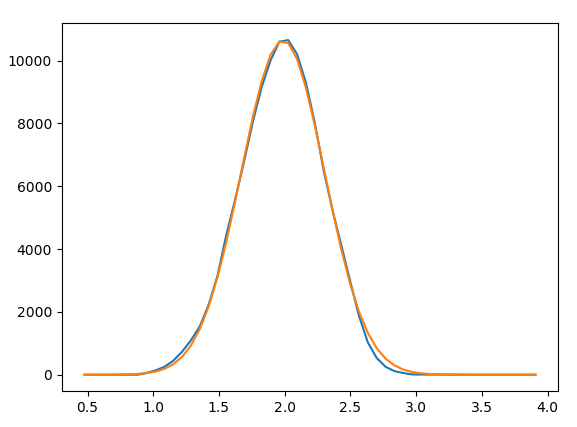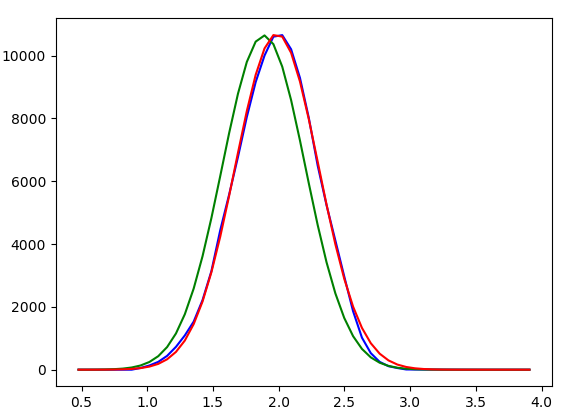我想计算正态分布数据的百分位数,所以我首先将数据拟合成正态分布,示例如下:
from scipy.stats import norm
import numpy as np
from scipy.optimize import curve_fit
import matplotlib.pyplot as plt
x = np.array([ 0.47712125, 0.5445641 , 0.61193563, 0.67924615, 0.74671202,
0.81404772, 0.88144172, 0.94885291, 1.01623919, 1.08361011,
1.15100191, 1.21837793, 1.28578227, 1.3531658 , 1.42054981,
1.48794397, 1.55532424, 1.62272161, 1.69010744, 1.75749472,
1.82488047, 1.89226717, 1.9596566 , 2.02704774, 2.09443269,
2.16182302, 2.2292107 , 2.29659719, 2.36398595, 2.43137342,
2.49876254, 2.56614983, 2.63353814, 2.700926 , 2.76831392,
2.83570198, 2.90308999, 2.97008999, 3.03708997, 3.10408999,
3.17108999, 3.23808998, 3.30508998, 3.37208999, 3.43908999,
3.50608998, 3.57308998, 3.64008999, 3.70708999, 3.77408999,
3.84108999, 3.90808999])
y = array([ 0.00000000e+00, 0.00000000e+00, 0.00000000e+00,
0.00000000e+00, 0.00000000e+00, 0.00000000e+00,
0.00000000e+00, 5.50000000e+01, 1.33500000e+02,
2.49000000e+02, 4.40000000e+02, 7.27000000e+02,
1.09000000e+03, 1.53000000e+03, 2.21500000e+03,
3.13500000e+03, 4.44000000e+03, 5.57000000e+03,
6.77000000e+03, 8.04500000e+03, 9.15500000e+03,
1.00000000e+04, 1.06000000e+04, 1.06500000e+04,
1.02000000e+04, 9.29000000e+03, 8.01500000e+03,
6.50000000e+03, 5.24000000e+03, 4.11000000e+03,
2.97000000e+03, 1.86000000e+03, 1.02000000e+03,
5.26500000e+02, 2.49000000e+02, 1.11000000e+02,
5.27000000e+01, 6.90825000e+00, 4.54329000e+00,
3.63846500e+00, 3.58135000e+00, 2.37404000e+00,
1.81840000e+00, 1.20159500e+00, 6.02470000e-01,
3.43295000e-01, 1.62295000e-01, 7.99350000e-02,
3.60750000e-02, 1.50000000e-02, 3.61500000e-03,
8.00000000e-05])
def datafit(x,N,u,sig):
y = N/(np.sqrt(2*np.pi)*sig)*np.exp(-(x-u)**2/2*sig**2)
return y
popt,popc = curve_fit(datafit,x,y,p0=[np.max(y),2,2])
Normal_distribution = norm(loc = popt[-2],scale = popt[-1])
然后我检查了 (x,y) 和 (x,popt[0]*Normal_distribution.pdf(x)) 的图是否相同,但结果显示它们完全不同......

蓝线是 (x,y) 的图,橙色线是 (x,popt[0]*Normal_distribution.pdf(x) 的图。
为什么会发生这种情况?我的代码有什么问题吗?
最佳答案
取决于你绘制的内容,这些对我来说看起来不错:
plt.plot(x,y)
Out[3]: [<matplotlib.lines.Line2D at 0xb9cef98>]
popt,popc
Out[4]:
(array([ 8.41765250e+04, 1.98651581e+00, 3.15537860e+00]),
array([[ 5.64670700e+05, 1.12782889e-05, 1.15455042e+01],
[ 1.12782889e-05, 2.91058556e-06, 2.73909077e-10],
[ 1.15455042e+01, 2.73909077e-10, 2.88523818e-04]]))
plt.plot(x,datafit(x,*popt))
Out[5]: [<matplotlib.lines.Line2D at 0xb990080>]
我的猜测是您的 datafit def 与norm() 中的 sig、scale 和 *,/存在错误
我重写了 datafit 以匹配 scipynorm.pdf
仍然存在~pi问题的因素,这可能只是定义性的:https://en.wikipedia.org/wiki/Normal_distribution
哎呀,看起来“pi 因子”只是您的特定数据的巧合
重读norm.pdf def建议整体按“比例”因子重新调整,所以现在我认为应该是:
'''
norm.pdf(x) = exp(-x**2/2)/sqrt(2*pi)
norm.pdf(x, loc, scale) == norm.pdf(y) / scale with y = (x - loc) / scale
'''
def datafit(x,N,u,sig):
# y = N/(np.sqrt(2*np.pi)*sig)*np.exp(-(x-u)**2/2*sig**2)
y = N*np.exp(-((x-u)/sig)**2/2)/(np.sqrt(2*np.pi))
return y
popt,popc = curve_fit(datafit,x,y,p0=[np.max(y),2,2])
# scipy norm.pdf with scaling factors to match datafit()
Normal_distribution = popt[0]*popt[2]*norm.pdf(x, popt[1], popt[2])
plt.plot(x,y, 'b')
plt.plot(x, datafit(x+.1, *popt), 'g')
plt.plot(x, Normal_distribution, 'r')
关于python - Python中正态分布的曲线拟合,我们在Stack Overflow上找到一个类似的问题: https://stackoverflow.com/questions/42882309/

